- About us
- Support the Gallery
- Venue hire
- Publications
- Research library
- Organisation chart
- Employment
- Contact us
- Make a booking
- Onsite programs
- Online programs
- School visit information
- Learning resources
- Little Darlings
- Professional learning
Olive Cotton (1911–2003) and Max Dupain OBE (1911–1992) were pioneering modernist photographers. Cotton’s lifelong obsession with photography began at age eleven with the gift of a Kodak Box Brownie. She was a childhood friend of Dupain’s and in 1934 she joined his fledgling photographic studio, where she made her best-known work, Teacup Ballet, in about 1935. Throughout the 1930s, Dupain established his reputation with portraiture and advertising work and gained exposure in the lifestyle magazine The Home. Between 1939 and 1941, Dupain and Cotton were married and she photographed him often; her Max After Surfing is frequently cited as one of the most sensuous Australian portrait photographs. While Dupain was on service during World War II Cotton ran his studio, one of very few professional women photographers in Australia. Cotton remarried in 1944 and moved to her husband’s property near Cowra, New South Wales. Although busy with a farm, a family, and a teaching position at the local high school, Cotton continued to take photographs and opened a studio in Cowra in 1964. In the 1950s, Dupain turned increasingly to architectural photography, collaborating with architects and recording projects such as the construction of the Sydney Opera House. Dupain continued to operate his studio on Sydney’s Lower North Shore until he died at the age of 81. Cotton was in her seventies when her work again became the subject of attention. In 1983, she was awarded a Visual Arts Board grant to reprint negatives that she had taken over a period of forty years or more. The resulting retrospective exhibition in Sydney in 1985 drew critical acclaim and has since assured her reputation.
Purchased 2010
The Photographer’s Shadow (Olive Cotton and Max Dupain) is a black and white gelatin silver photograph on paper, the sheet measuring 30.4 cm by 25.2 cm and the image 16.6 cm by 15.2 cm.
The photograph was taken circa 1935 by Olive Cotton; her shadow is cast over the bare upper body of Max Dupain who is lying on a beach.
Taken from a small distance and looking down onto Dupain’s body, he is is effectively upside down in the image. His waist meets the top edge of the photograph where a hint of a waistband is visible, his head half way down and in the centre. Light shines brightly on the sand all around him, it is flecked with multiple tiny pebbles, some black and others many gradients of lighter tones. The spare ripples of his ribs define the slim shape of Dupain’s chest, a dark nipple on our right stands out on an otherwise pale-skinned torso. Both his arms are stretched out so that his underarm hair is visible, his elbows are bent outside the image while both his hands cradle the top of his head, fingers splayed out. A small section of a striped towel is folded back on its self under his left shoulder.
Cotton’s dark silhouetted head covers Dupain’s upper chest in shadow; her neck his mouth, her shoulders his head and hands, so that these features are in sharp contrast to the sunlit areas of his body and some details are hard to distinguish. A small line of bottom teeth helps to define the large rectangular shape of his open mouth which is wide as if in exclamation. The lines around his nose down to his chin are deep and make an oval shape amplifying the dark void of his mouth. Dupain wears large white round-rimmed sunglasses, the top of his head and his hair is too shadowed to describe.
The outline of Cotton’s shadow is crisp. It suggests a head with short but full-bodied hair blown to the right, square shoulders, elbows out from her body and arms bent inwards to her waist, suggesting she is holding the camera against her stomach. Small triangles of light and sand peep through the spaces between her arms and body. Her broad hips are cropped by the bottom edge of the photograph.
Audio description written and recorded by Annette Twyman, 2021



On one level The Companion talks about the most famous and frontline Australians, but on another it tells us about ourselves.
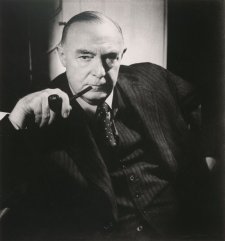
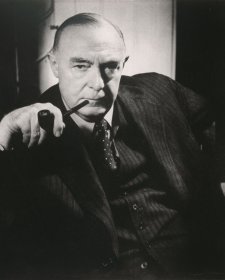
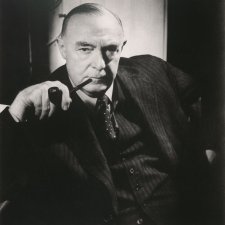
Johanna McMahon revels in history and mystery in pursuit of a suite of unknown portrait subjects.
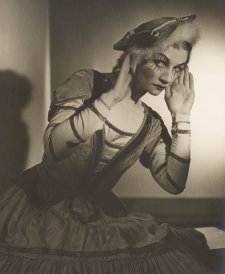
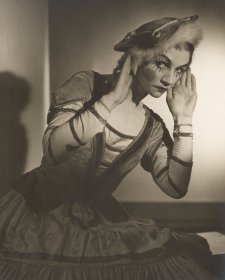
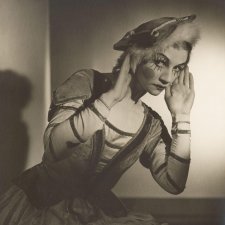
Gael Newton delves into the life and art of renowned Australian photographer, Max Dupain.